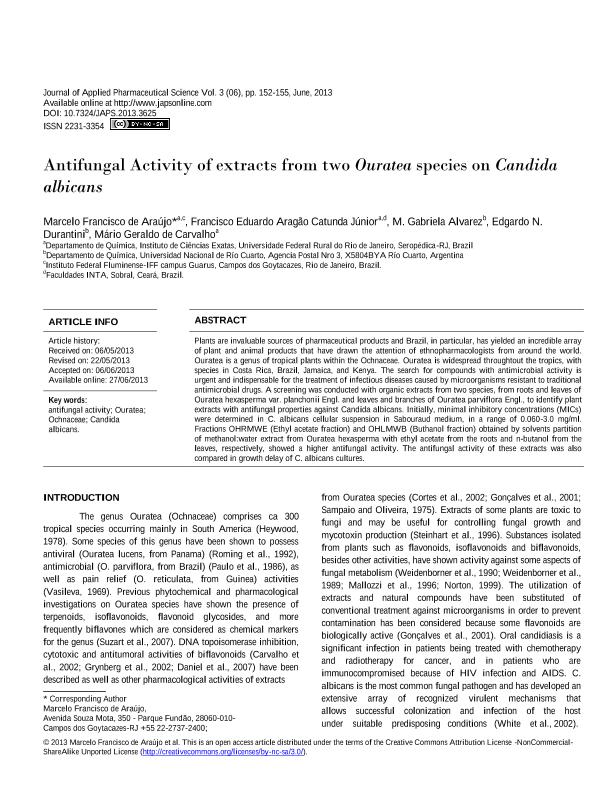Mostrar el registro sencillo del ítem
dc.contributor.author
de Araújo, Marcelo Francisco
dc.contributor.author
Catunda, Francisco Eduardo Aragão
dc.contributor.author
Alvarez, María Gabriela

dc.contributor.author
Durantini, Edgardo Néstor

dc.contributor.author
Carvalho, Mário Geraldo de
dc.date.available
2017-08-31T20:13:44Z
dc.date.issued
2013-06
dc.identifier.citation
de Araújo, Marcelo Francisco; Catunda, Francisco Eduardo Aragão; Alvarez, María Gabriela; Durantini, Edgardo Néstor; Carvalho, Mário Geraldo de; Antifungal Activity of extracts from two Ouratea species on Candida albicans; World association of Medical Editors; Journal of Applied Pharmaceutical Science; 3; 6; 6-2013; 152-155
dc.identifier.issn
2231-3354
dc.identifier.uri
http://hdl.handle.net/11336/23392
dc.description.abstract
Plants are invaluable sources of pharmaceutical products and Brazil, in particular, has yielded an incredible array of plant and animal products that have drawn the attention of ethnopharmacologists from around the world. Ouratea is a genus of tropical plants within the Ochnaceae. Ouratea is widespread throughtout the tropics, with species in Costa Rica, Brazil, Jamaica, and Kenya. The search for compounds with antimicrobial activity is urgent and indispensable for the treatment of infectious diseases caused by microorganisms resistant to traditional antimicrobial drugs. A screening was conducted with organic extracts from two species, from roots and leaves of Ouratea hexasperma var. planchonii Engl. and leaves and branches of Ouratea parviflora Engl., to identify plant extracts with antifungal properties against Candida albicans. Initially, minimal inhibitory concentrations (MICs) were determined in C. albicans cellular suspension in Sabouraud medium, in a range of 0.060-3.0 mg/ml. Fractions OHRMWE (Ethyl acetate fraction) and OHLMWB (Buthanol fraction) obtained by solvents partition of methanol:water extract from Ouratea hexasperma with ethyl acetate from the roots and n-butanol from the leaves, respectively, showed a higher antifungal activity. The antifungal activity of these extracts was also compared in growth delay of C. albicans cultures.
dc.format
application/pdf
dc.language.iso
eng
dc.publisher
World association of Medical Editors
dc.rights
info:eu-repo/semantics/openAccess
dc.rights.uri
https://creativecommons.org/licenses/by-nc-sa/2.5/ar/
dc.subject
Antifungal
dc.subject
Candida Albicans
dc.subject
Yeast
dc.subject
Extract
dc.subject.classification
Otras Ciencias Químicas

dc.subject.classification
Ciencias Químicas

dc.subject.classification
CIENCIAS NATURALES Y EXACTAS

dc.title
Antifungal Activity of extracts from two Ouratea species on Candida albicans
dc.type
info:eu-repo/semantics/article
dc.type
info:ar-repo/semantics/artículo
dc.type
info:eu-repo/semantics/publishedVersion
dc.date.updated
2017-08-30T13:52:59Z
dc.journal.volume
3
dc.journal.number
6
dc.journal.pagination
152-155
dc.journal.pais
India

dc.description.fil
Fil: de Araújo, Marcelo Francisco. Universidade Federal Rural do Rio de Janeiro; Brasil
dc.description.fil
Fil: Catunda, Francisco Eduardo Aragão. Universidade Federal Rural do Rio de Janeiro; Brasil
dc.description.fil
Fil: Alvarez, María Gabriela. Universidad Nacional de Río Cuarto. Facultad de Ciencias Exactas Fisicoquímicas y Naturales. Departamento de Química; Argentina. Consejo Nacional de Investigaciones Científicas y Técnicas; Argentina
dc.description.fil
Fil: Durantini, Edgardo Néstor. Universidad Nacional de Río Cuarto. Facultad de Ciencias Exactas Fisicoquímicas y Naturales. Departamento de Química; Argentina. Consejo Nacional de Investigaciones Científicas y Técnicas; Argentina
dc.description.fil
Fil: Carvalho, Mário Geraldo de. Universidade Federal Rural do Rio de Janeiro; Brasil
dc.journal.title
Journal of Applied Pharmaceutical Science
dc.relation.alternativeid
info:eu-repo/semantics/altIdentifier/doi/http://dx.doi.org/10.7324/JAPS.2013.3625
dc.relation.alternativeid
info:eu-repo/semantics/altIdentifier/url/http://www.japsonline.com/abstract.php?article_id=940
Archivos asociados
